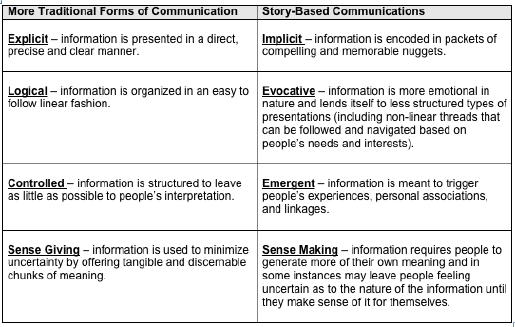See Terrence’s bio, photo, and Part 1 of this Q&A.
Q&A with Terrence Gargiulo (Question 2):
Q: Are there any current uses of storytelling that repel you or that you feel are inappropriate?
A: Stories can be used as weapons. Given their persuasive and emotional qualities they can be used to spin messages and misrepresent things. This sort of behavior eventually bears its ugly head but as in the case of short term forms of self-serving manipulation but it can be hard to detect or fend off. I see some of these types of abuses in the brand, marketing, and corporate communications arenas.
I also lose patience with some of the overly simplistic ways we all get sucked in to when we use stories to encode information in a moralistic fashion. I am just as guilty of this as the next person. Using stories to land a message or sound the trumpet of change and rally the troops around a single campfire reeks of top down command and control applications of didactic forms of communications. I’m not suggesting we never use stories to help illustrate points but such uses only scratch the surface. I see too many of these abuses in the field of leadership development and personal growth.
Here’s one way of discerning the difference between more traditional forms of communications and story-based ones:
 Think of story-based communication strategies as cloud chambers in your organization…
Think of story-based communication strategies as cloud chambers in your organization…
Cloud Chamber — apparatus that detects high-energy particles passing through a supersaturated vapor; each particle ionizes molecules along its path and small droplets condense on them to produce a visible track (definition courtesy of www.answer.com)
They create a space of dialogue and sense making. This “story space” is where people interact with each other’s stories in different ways. Some interactions might occur as people reflect and react to organizational collaterals peppered with stories, some interactions might happen when we create formal and informal opportunities for people to respond to the stories we use to incite dialogue, and still other interactions, once we have put the initial stories out there, will happen without us doing anything whatsoever to orchestrate them. As stories elicit more stories by bouncing off of each other, organizational trajectories of meaning and understanding emerge. People’s actions provide a visible albeit subtle and ghostly trace of the impact of story-based communications.
Stories are not another lever in a machine. Machines or systems take known controlled inputs that produce reliable and consistent outputs. Stories are more chaotic. Once you stir up or perturbate the social fabric of individual nodes of sense making (aka the people in an organization) unexpected behaviors emerge. What is lost in control is gained in the propagating strength of the communication signal and the rolling waves of self-directed behaviors it has the potential to create. Communications function less like instructions and more like picture frames waiting to be filled with collages of vibrant photographs.
